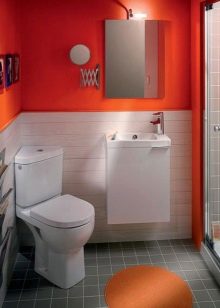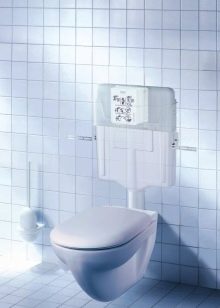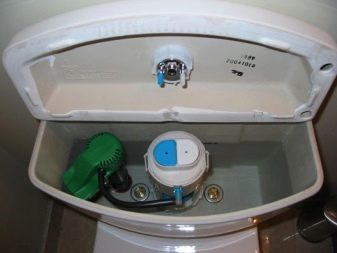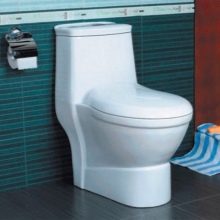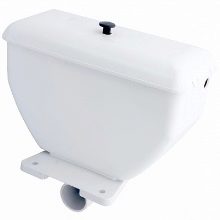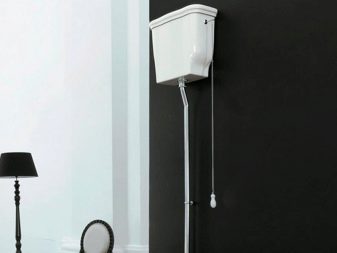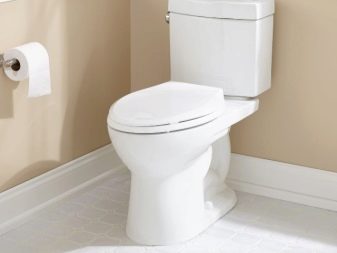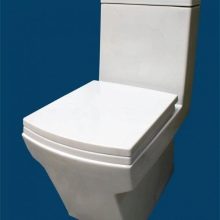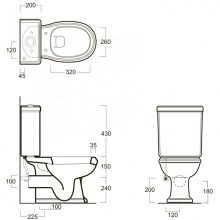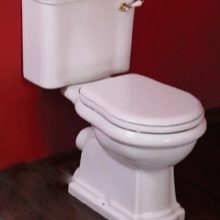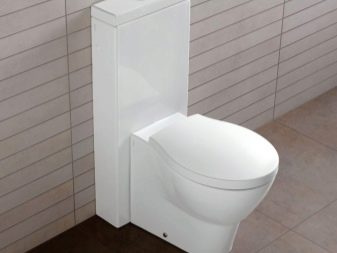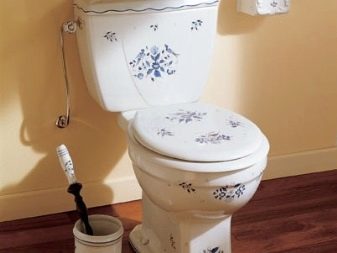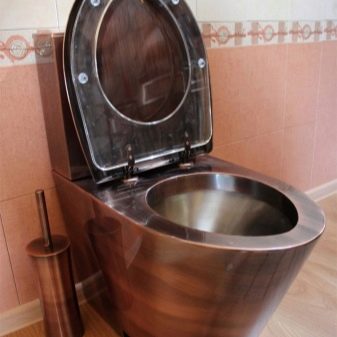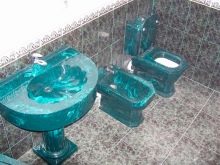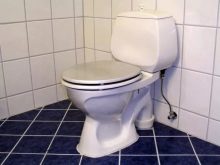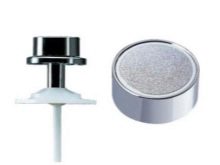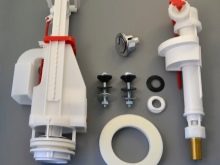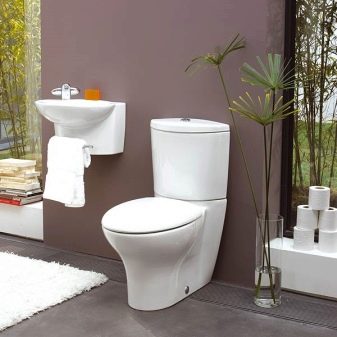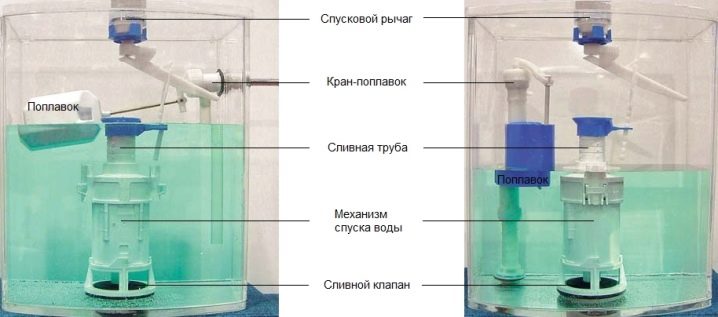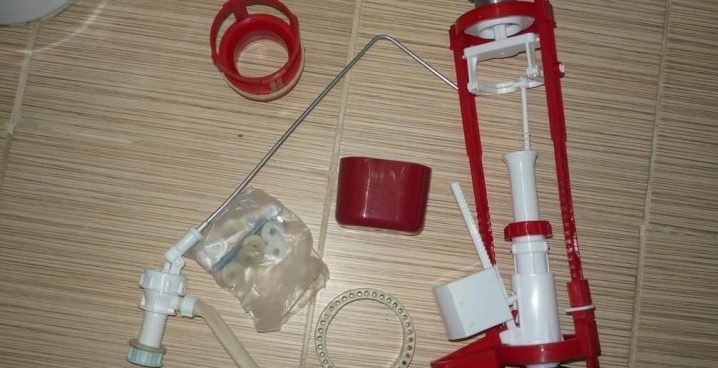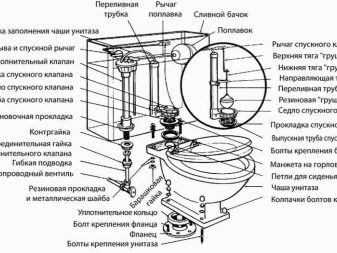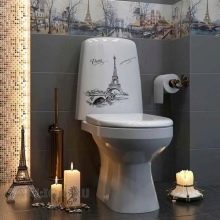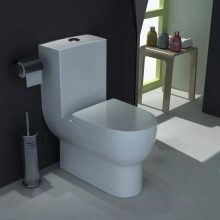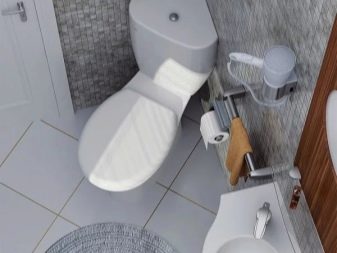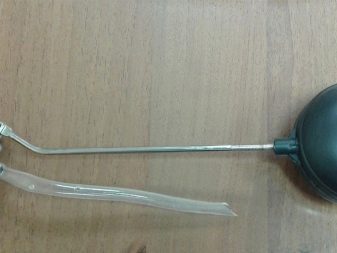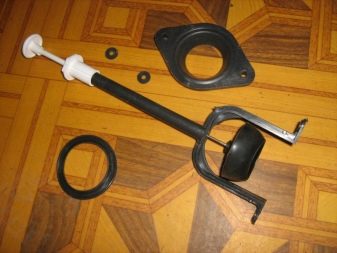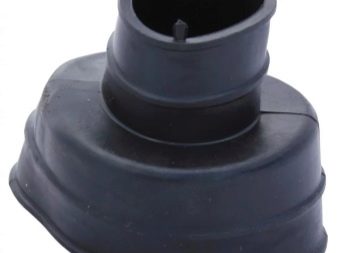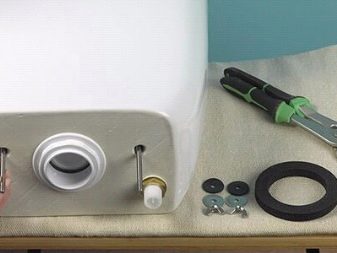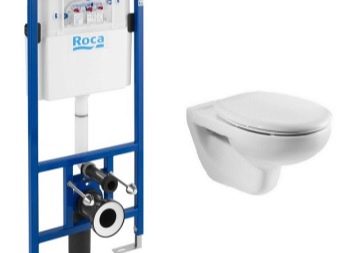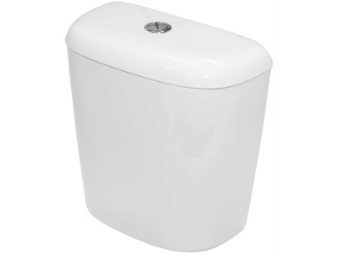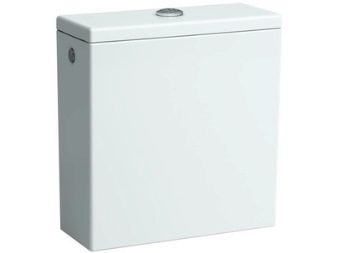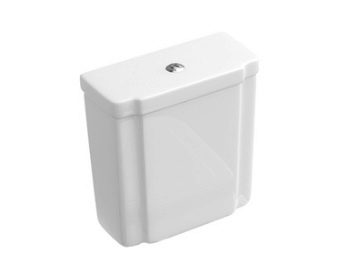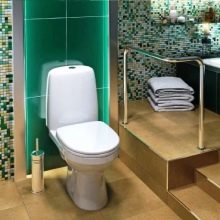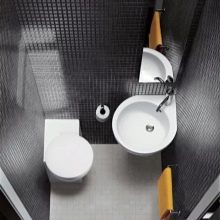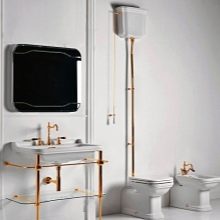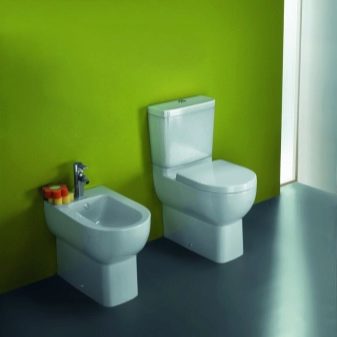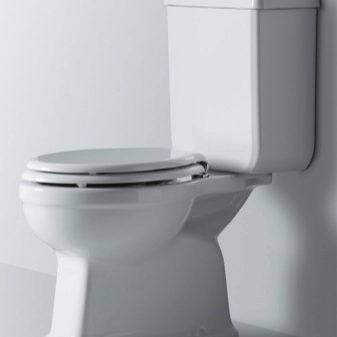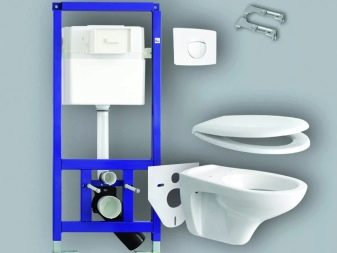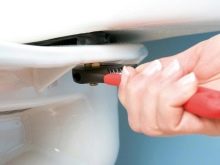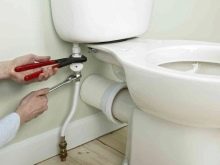Tank for toilet: choose the perfect device
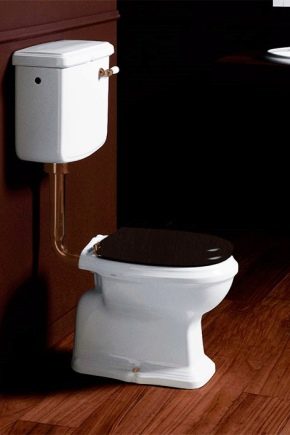
The toilet cistern is probably the most problematic element among all plumbing fixtures. It often fails, violating the functionality of the entire bathroom, in addition, for a certain plumbing you need to choose your type of this device, and the design plays an important role. Therefore, it is worthwhile to learn more about how to choose the perfect toilet bowl device.
Special features
The main functional element of the toilet bowl - the flush tank - despite many modifications and different designs, for more than 150 years has remained unchanged on the principle of operation.This is a container, most often of ceramic, containing a mechanical device with manual control. Its function is to provide an intensive flow for a quick flush, which forms a plug of water and “closes” odors. A toilet bowl is connected to the water supply system through a hose system, a capacity of a certain volume is needed to accumulate enough water for flushing.
Toilet tanks generally have 2-3 technological holes for the supply and discharge of water. Inside, flush tanks have mechanisms for shutting off the liquid when it fills the desired volume and for flushing it into the bowl. Drainage occurs by gravity.
Toilet bowls can be separate or compact. In addition, there are variants of monoblock, where the water tank and toilet bowl are made in a single, inseparable case.
Kinds
Almost all domestic toilets of the old sample had a separate drain tank. This means that it is separated from the bowl and suspended at a height, and a pipe is used to feed the water down. The advantages of this performance is that the pressure is very strong, therefore, the higher the capacity is, the more intensive the flush.The mechanism for flushing the cistern, which is located separately, is simpler, it occurs with the help of a rope. But such a performance with a tank suspended from the ceiling, many find not too aesthetic and presentable.
Unlike separate devices that have a mounted tank, the compact type has a capacity for water accumulation, located directly on the toilet - in its rear part behind the bowl. It is believed that this is a newer type of plumbing, although it was invented more than a century ago. These toilets have a more aesthetic appearance, take up less space. There is no need to hang up a bulky and heavy container at a height; instead, toilet shelves can be placed above the full height of the toilet up to the ceiling. Tanks of the compact type are most often made with a button, with the help of which flushing is performed, less often are models with a lever.
Monoblock is a single inseparable design of the toilet bowl and tank, the latter is located above the cup behind. This model is molded immediately on the production of ceramics, metal or plastic. It is impossible to disassemble the fragments, it complicates transportation, and makes plumbing more cumbersome.But there are also advantages: the monoblock is more hygienic - there are no places of the tank and bowl joints, under them and dirt and rust do not accumulate under the rubber seal. The monolithic design also looks more stylish and harmonious.
Monoblock can be floor or suspended. The latter design is more difficult to install, because you need to install the entire system so that it can withstand the weight of a seated person. But on the other hand, it looks very original, and most importantly, it is easier to clean the floor under the toilet.
The location of the toilet tank can be external or hidden in a niche false walls.
The latter type of installation is more complicated, in any case, you must install a partition and lay a complex outlet hose. But on the other hand, it has an original look, in the case of installing a side toilet to the false wall, a lot of additional space is freed up, the area around the device is easier to clean.
According to the materials of manufacture toilet bowls can be:
- Ceramic - the most common form. Ceramics are relatively durable, easy to clean, have a characteristic glossy shine and can have not only white, but also many other colors, which allows you to choose sanitary ware in accordance with the rest of the toilet room interior.
- Earthenware - these were the very first toilet bowls made in the second half of the 19th century. This material is quite brittle, in addition, it has a porous structure, which complicates its cleaning, and dirt and microbes accumulate in the pores. Modern developments can reduce these drawbacks, but still faience as a material for the manufacture of sanitary ware for the toilet has lost its popularity.
- Porcelain toilet bowls, like ceramic, have a smooth, pore-free surface that is easy to clean. The strength is somewhat less than that of ceramics, the view can be very presentable. But because of the high cost of porcelain tanks and toilets are not too popular.
- Metal cisterns for a toilet bowl on durability and ease surpass ceramics. The characteristic dark shine looks very stylish and is suitable for a toilet room with a modern design. The materials most commonly used are stainless steel or cast iron. The latter option is more fragile and difficult, so the choice is better to make in favor of steel tanks.
- Glass and natural or artificial stone also used for the manufacture of toilet bowls, so complete with them you can purchase the corresponding cisterns.Such products usually belong to the class of elite, often they are installed in interiors decorated in modern style. The price of such goods is high, in addition, they can be fragile.
- Reinforced acrylic today it is widely used for the production of bathtubs, toilets, there are toilet tanks from it. The material is smooth, non-porous, has a well-cleaned surface of saturated white color. The advantage is that with good strength, it is lighter than ceramics, in addition, it is hygienic.
- Plastic it is applied to toilet cisterns hidden in a wall niche. Since such capacity is not visible, there are no visual requirements for it, as long as the mechanism functions reliably.
The material and color of the tank should be combined with the toilet: for the ceramic device is selected ceramics for steel - the same steel. Similarly, the selection of tanks made from other materials.
According to the method of fluid supply, drain tanks can be with side or lower water connections. In the first case, the hose is located on the right or left in the upper part of the device, in the second - from the bottom. Bottom liner is good because the hose is almost invisible,on each side of the tank is free space. But such devices are more difficult to repair, and the pressure of the water to fill the need for intense.
The locking device or valve for the drain tank is a piston or diaphragm. The first type is driven by a lever with a piston, at its end there is a gasket blocking the flow of water into the tank. Valves having a silicone or rubber membrane, allow you to quietly and in a short time to get water in the tank, but they are very sensitive to cleanliness.
Drain tanks with a button are of three types:
- Single-mode drain - drain when all the water is poured when the button is pressed.
- With the “stop” mode, when the first press starts a drain, and the second one stops it.
- The dual-mode drain has two digging points: the first is for draining a part of the water, the second for completely emptying the tank.
In addition to the button, the drain mechanism can be actuated by a rod or a lever. Exhaust systems drain water by raising the stem. Such a tank has a fairly simple device; it is easier to repair than a button design.Lever mechanisms have a lever on the side or bottom, the device is triggered by pressing it. Such tanks can be compact models, and separate.
The shape of the external drain tanks can be wall or corner. The second type is needed if the toilet is placed in the corner of the room.
So you can save free space in the toilet, and use the bathroom no less comfortable than with the standard version.
Principle of operation
Both old-style flush cisterns and modern systems with two modes of operation have similar device and functionality.
This mechanism includes the following details:
- stop valves;
- bulk valve;
- system to prevent water overflow.
In order to control the discharge of water and to prevent the leakage of fluid unnecessarily, there is a drain or shut-off valve with a valve with a plug that blocks the opening leading to the toilet bowl. The valve is fully pressed to it under the pressure of the water in the tank. If a constant continuous leakage is observed in the toilet, the device malfunction is connected with the drain valve.
The filling valve serves to pass water from the water supply system to the tank capacity and its closing, when it is completely filled. The scheme of work is arranged as follows: this valve has a connection, usually made in the form of a brass rod with a float, which, in turn, rises along with the water level and during filling closes the flow of fluid from the outside. In the old systems, the filling valve was located on the side, and the float was placed horizontally, new models of drain tanks have a filling valve at the bottom and a vertical float made of lightweight plastic. Most often toilet bowl breakdowns are associated with this device.
The drain and overflow systems available on most modern tank models are designed to ensure that when a drain valve, float or filling valve fails, the water is poured not onto the floor of the toilet, but into the sewer system. Special hoses are provided for this.
If the water blocking mechanism is broken, then it does not flow over the edge of the tank, but enters through them and is discharged into the drain communications.
Dimensions
The volume of a standard cistern of separate type or compact is 6 liters.At the same time, a ceramic product with all internal reinforcement weighs 10–11 kg. The weight of an acrylic device similar in volume will be less. Plastic container, which is embedded in the false wall, has a minimum mass.
Dimensions of separate flush tanks or compact type may be different.
The most common options are:
- height with cover - 350-400 mm;
- length - 300-360 mm;
- width - 150-200 mm.
To save space often install a toilet in the corner of the toilet, this method is also common in the combined bathrooms.
For such an arrangement, angular drain tanks are selected that are compact and not inferior in size to conventional types. The smallest similar product may have a width of 275 mm. The toilet bowl of a monoblock with an integral can can have a height from the floor to the top of the cover from 820 mm.
Accessories
The main functional element of the tank - internal fittings - contains the following blocks: float mechanism and drain system.
They, in turn, have individual components.
- The float, usually made of plastic, has an air cavity inside it. This is a kind of water seal that floats with the water level and at a certain point with the help of a system of levers blocks the flow of fluid from the aqueduct.The float itself is practically not exposed to any negative effects, but its links with a plug made of brass, other metals and plastic most often fail.
- To open and close the drain hole, there is a “pear”, which rises up when the water is released, and when the tank is emptied and filled, it again goes down until it is fully pressed against the saddle. This happens with the help of a vertical guide tube made of plastic and an internal cavity. It contains air, which pushes the pear up. This part is also subject to deformation, cracking, so it often has to be replaced.
- Cuff for connecting the tank and flushing the toilet. This element is not a drain mechanism, but a secure attachment of the container and bowl. It is her tightness that determines the absence of leaks on compact models. If at the junction of the toilet bowl and the tank there are traces of moisture, the fault lies precisely in the cuff, and it must be replaced. And when installing a new part for reliability, it is best to additionally lubricate with sealant or silicone.
- Fastening bolts and gaskets for them. These fasteners are present in compact tanks.They are not responsible for the discharge process, but for reliability and normal operation of the device it is worth checking their condition.
- Ring laying in systems of discharge and overflow. This detail is found in modern models and often fails. It is responsible for the tightness and reliable pumping of water into the sewage system in case of failure, so it is worth monitoring its condition.
The remaining components of the toilet cistern are: body, lid, rod, lever or buttons. These parts are less susceptible to breaking, but the main thing is to monitor their integrity and wash them regularly.
Manufacturers Overview
Most often, flush cisterns are sold complete with toilet bowls. Therefore, in the event of a breakdown, it is best to choose original components for your plumbing. In this case, the dimensions will be identical, there will be no problems with the installation, and all the details will be harmoniously combined.
Roca victoria - it is high-quality faience sanitary products from the brand Roca. It is possible to purchase cisterns for floor toilets with a volume of 6 liters. Products have an elegant oval shape with a white glossy shade.
The water supply is carried out from below, there are two modes of operation: full drain and water discharge of 3 liters each, on the lid there is a double metal button for this. Tank dimensions: 18.5x37x39.5 cm. The product is guaranteed for 10 years.
Toilet tanks complete with drain fittings Cersanit Olimpia designed for compact type toilet bowls. They are made of high quality white faience, rectangular shape with smooth corners. The water supply is at the bottom right, there is a double mode for full and half discharge, the full volume of the tank is 6 liters. Product dimensions: 17x36x37.5 cm, weight complete with fittings - 11.9 kg.
Porcelain Tanks Keramin Grand Will be suitable for floor toilet bowls Verona, Cesaro, Keramin. Trapezoidal shape, narrowed at the bottom, white color. Products have a beautiful appearance and reliable performance, given a five-year warranty. Bowl dimensions: 17x38x38.5 cm.
Drain tanks for floor toilets Laufen pro have an original look with strict rectangular shapes. Production material - porcelain, product weight - 13 kg, the water supply is carried out from the side. The volume of the tank is 4.5 liters, the dual-mode drain is provided - 3 liters each and all.
Tank with drain fittings Villeroy & Boch Hommage in appearance and form it is very original, suitable for an elite design of a combined bathroom. The product made of porcelain has a soft glossy shade, weight - 14.5 kg, full volume - 6 l.The water supply is on the right, on the top cover there is a double button for a complete drain or 3 liters of water.
How to pick up?
First of all, the choice of the cistern, as well as the toilet itself, depends on the characteristics of the toilet room. For small areas worth buying compact models with small dimensions. Often in this case it is optimal to choose a small bowl and the angular design of the drain tank, which occupies a minimum of space. The triangular profile of such a tank at the expense of greater height may not be inferior to the volume of ordinary models.
Lovers of the classics sometimes install separate tanks with a long metal pipe, hanging high under the ceiling, under the overall style of the apartment and bathroom. But the appearance may affect operation. Oblong pipe, as well as the joints have to be repaired more often, it can become clogged with sediment of tap water, access to the tank is complicated.
The most practical and reasonable option is to install a toilet bowl with a compact type tank.In addition, a huge number of variants of design of this model are presented. In the event of a breakdown, it is easier to repair them, shut-off valves and the drain valve can be removed simply by lifting the lid, often it is not even necessary to dismantle the tank itself for repair.Yes, and they are easier to use, because, unlike separate systems, such devices can have two modes of operation.
The choice of the volume of the drain tank is not very wide, most often represented by a capacity of 6 liters, this is enough for efficient operation. To save water and useful space in the toilet you can buy compact products with a volume of 4 - 4.5 liters. Also, when buying, you should pay attention to the mass of the cistern, calculate it so that the toilet or the frame built into the wall can withstand such a weight. The most common weight of earthenware and ceramic products in the range from 9 to 13 kg.
Installation Tips
If the toilet cistern has a separate structure and is mounted as a suspended one, then reliable beams should be mounted for fastening it to the wall. It is best to use metal brackets that are fixed in concrete to an anchor or screws with dowels. The weight of a cast-iron or steel tank filled with 6 liters of water is quite large and requires reliable vertical fixation.
The inlet pipe at the junction of the lower opening of the tank and the drain bowl must be sealed with a rubber gasket and treated with silicone or sealant.
The compact tank, installed directly on the toilet, must also be securely connected. For this, bolts, usually included in the kit, are used. Rubber joints should be placed in the joints. Drain hole coming out of the tank into the bowl, it is necessary to provide a cuff and lubricate it with a sealed solution.
All tubes, supply and output hoses, corrugations should be tightened until it stops, ensuring reliable sealing. It is still not superfluous to check the installation of the tank strictly on a horizontal level.
Recommendations for use
Properly installed toilet bowl of any type can be operated for a long time. It is necessary to wash it regularly and occasionally look under the cover, checking the integrity of the drain mechanism. In the case of the slightest leakage or disruption of the work, the paste should be repaired
To learn how to repair the leaking toilet tank yourself, see below.
